

When Aaron Lane sold his claim at the upper crossing to Dr. Woodville Andrews, he took a note for $575 to secure the property, which was the full purchase price. Andrews failed to honor the note and in January of 1867 Lane filed suit against him.
In response to Lane's action, Andrews conceded he issued the note, but claimed he was a victim of fraud, having been notified by Lane's former neighbor, Joseph Highmoor, that a portion of the land was in dispute. The written notice Highmoor sent to Andrews, dated September 18, 1865, stated the following:
Dear Sir, Having heard that you had purchased a claim of Land belonging to me and duly recorded which claim lies on the Mohave River, south of west of Lanes claim. You will take notice that I have not abandoned my claim and still intend to purchase the land of the Government, so soon as the land comes into market.... Very Respectfully |
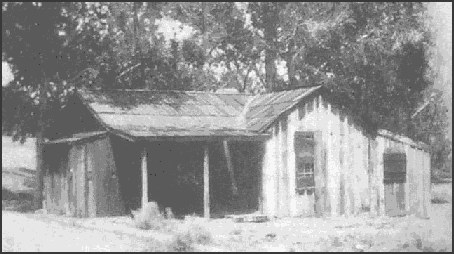
LANE'S SECOND HOUSE AS IT APPEARS IN A PHOTOGRAPH TAKEN MANY YEARS LATER. THE BATTEN-BOARD CONSTRUCTION WAS A COMMON STYLE OF THE PERIOD. THE HOUSE WAS BUILT PRIOR TO THE SPRING OF 1863, FOR AT THAT TIME THE EDWARD PROTHERO FAMILY IS LISTED AS LIVING IN "IMPROVEMENTS" ON LANE'S PROPERTY, INDICATING AT LEAST TWO STRUCTURES EXISTED. FURTHER EVIDENCE THAT LANE HAD MORE THAN ONE HOUSE IS GIVEN IN THE DEED AT THE TIME HE SOLD THE RANCH TO DR. WOODVILLE ANDREWS, WHICH STATES LANE WAS SELLING HIS "HOUSES" ON THE PROPERTY. |
LANE'S NEIGHBOR, JOSEPH HIGHMOOR
Joseph Highmoor was an early resident at the upper crossing, and he must have settled there at about the same time as Lane. In the same May 14, 1859, issue of the Los Angeles Star that described the Indian attack at Lane’s, there is a reference to "Highmore's crossing" by a Major Samuel Heintzelman, who had camped there on May 4, 1859. Highmoor would have been one of the "others" referred to in the Indian raid as having lost "all their worldly goods."
Lane and Highmoor most likely were acquaintances even before they moved to the desert. They both lived in close proximity in east San Bernardino, Highmoor's property being just north of the Timber Settlement near Warm Creek. Also, Highmoor, like Lane, was a Mexican War veteran. Conceivably, the two men made the decision together to move to the upper crossing with the idea of establishing a settlement there.
Victim of Outlaws
In August of 1859, only a few months after the Indian raid on the upper crossing, Highmoor was victimized by three men running stolen horses out through Cajon Pass to the Mojave Desert. The men had been working for rancher Don Fernando Sepulveda. They stole three of his fine horses, one of which was said to be worth $500, and fled towards the pass, with Don Fernando in pursuit:
[Sepulveda], accompanied by Joaquin Valenzuela, followed them into the Cajon Pass, en route for the Mohave river, when [he] met an expressman coming into San Bernardino, who brought information of the robbers having attacked and robbed the house of Mr. Highmore, at the head of the Mohave; and also that they had attacked two Mexicans, connected with a pack train, who were returning from Beale's Crossing. These two Mexicans they robbed and wounded, leaving one of them for dead. The express rider advised Sepulveda to return to San Bernardino for assistance, as there was another party of several white men camped lower down on the Mohave river, with a band of horses, who were probably connected with, and waiting for the party who stole the horses from Sepulveda, to join them. |
Shoots Lane
Life at the upper crossing was not to Highmoor's liking, nor probably his family's, which consisted of a wife and young daughter. The episodes with the Indians and the desperadoes had put him and his family in imminent danger, but it was a confrontation with Aaron Lane that finally caused his departure from the desert. The incident was covered in the May 4, 1861, edition of the Star:
Fight. -- A fight occurred between Messrs. Lane and Highmore, of the Mojave, concerning hogs which were running at large. Lane was slightly wounded in the right arm. |
Several years later, in his September 1865 notice to Woodville Andrews, Highmoor made the statement, "I was necessarily compelled to leave temporarily, for my personal safety...." Although he did not specify where the source of the peril lie, it was shortly following the fight between the two neighbors that the Highmoors returned to San Bernardino.
This incident may help explain some of Highmoor's later actions regarding the land claims at the upper crossing. The animosity between Lane and Highmoor must have been great, so much so that the incident became well known and impressed in the memories of people for years afterwards.
A bastardized version of this tale has passed down through historians over the years, the origins of which can be traced back to Lane's contemporaries. As recently as 1963, L. Burr Belden repeated the story of Lane's supposed attempt to cheat the government out of a pension by claiming as a Mexican War injury the wound he received in a fight with a neighbor over some hogs. This is nonsense; Lane's complete pension file is a matter of record, and it is well documented that he had qualified as early as 1849 for a pension based on health problems.
Belden gave his source for the story as Dix Van Dyke, who, in turn, said he had heard it from San Bernardino attorney Byron Waters. Waters was not an unbiased source, having been the plaintiff's counsel in a bitter 1875 lawsuit in which Lane was the defendant.
Lane did not apply for his pension reinstatement until the late 1870s -- nearly two decades after his fight with Highmoor, and several years after Highmoor's death -- yet Waters, or someone else, remembered the feud over the hogs and pieced the two incidents together.
Encroaches on Lane's Property
Highmoor remained interested in the desert property for some time following his departure. In 1864 he filed another claim at the upper crossing, which was situated only one-quarter mile north and one-quarter mile west of his original site, which meant his claims overlapped. By this maneuver, Highmoor had pushed his boundaries into the southeast corner of what Lane considered his property, and the legality of this action was an issue in Lane v Andrews.
Woodville Andrews had stated in his response to Lane's suit that "at least one fourth of said premises were covered by a prior possessory claim duly surveyed and recorded in favor of said Hymore in the year 1859," but it is the 1864 claim that appears to overlap Lane's property.
Since the acreage in dispute held valuable natural springs, it is quite possible Highmoor filed the second claim to challenge Lane’s rights to this land. Lane had not been diligent in obtaining the necessary legal documents to secure his property, and this fact might have encouraged Highmoor to contest his claim.
Highmoor never returned to the upper crossing following his move to San Bernardino in 1861, despite his statement to Dr. Andrews that he was forced to leave "temporarily" for his personal safety. After he left, Lane's ranch was the only occupied property at the crossing for the years 1862 through 1865, as no one else is listed in the Auditor's Assessment Books at that time.

LANE STAYS AT CROSSING FOR AWHILE AFTER SALE
Dr. Andrews bought Lane's claim in April of 1865, and then worked an arrangement with Lane to share the property for a while, which is shown in an interesting incident that had its beginnings just about the time of Andrews' purchase. The May 23, 1865, issue of the Wilmington Journal ran a story about a Mr. Johnson at Lane's Crossing, who, around the first of the month, had found a flock of 1,040 sheep some four miles from Point of Rocks. Since a large flock of sheep had passed through San Bernardino on the way to Salt Lake the previous month, it was supposed that this was the source of the stray flock.
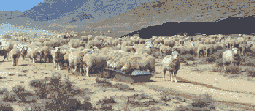
Public Administrator Dudley R. Dickey had heard a very similar story. Informants had told him that two men (whose names were then unknown, but who were later identified as Messrs. Wordwell and Thomas) were killed by Indians while herding four to five thousand sheep on the desert. A large number of the flock, nearly 1100 it was thought, had found their way back to the Mojave River.
According to Dickey's information, the sheep were in the custody of Dr. Andrews and James H. Johnson. Dickey wrote a letter, dated May 11, 1865, to Probate Judge A. D. Boren asking that an order be granted directing Andrews and Johnson, or anybody else in possession of the sheep, to deliver the property to the Public Administrator at once.
Judge Boren immediately issued an order to Andrews and Johnson, and stated in the document, "You are therefore required and commanded to deliver over said sheep to [the Public Administrator]...and to appear before the Probate Court on the 22nd day of May 1865 & show cause why you refuse and to give answer under oath touching said matter." When Deputy Sheriff Richard Mathews arrived at the upper crossing he found not Andrews, but Aaron Lane and Johnson, and so he amended the order to include Lane and issued the summons for them to appear in court.
As it so happened, Dickey's information regarding the deaths of the sheepherders was incorrect, as the June 17th issue of the Wilmington Journal showed them as still being among the living:
FOUND -- Mr. A. B. Wordwell and his party, who were reported as having been killed while driving sheep from San Bernardino to Salt Lake, have been seen near the Muddy on the Salt Lake Road. |
This would explain why the only documents contained in Case No. 145 of the Probate Court were Dickey's letter to Boren, Boren's order to Andrews and Johnson, and the summons delivered by the sheriff. Whatever the final disposition of the case, this episode indicates that James H. Johnson was running the ranch at the crossing, and shows that Lane was still in residence there.
Andrews kept his town home and continued his medical practice in San Bernardino, so it is very likely that during the time Lane was at the ranch he helped with the operation of the station and assisted Johnson with the transition. It was common during the pioneer years for Mojave ranchers to have business or professional interests elsewhere.
ANDREWS COUNTER-SUES
On September 18, 1865, Andrews received Highmoor's letter regarding ownership of the property. At that point he backed out of the sale, and two months later, on November 18th, he claimed 160 acres of his own, described as "East of what is generally Known as the old 'Hymore Claim,' at the first crossing of the Mohave River on the road from San Bernardino to Camp Cady, or great Salt Lake City."
Over a year elapsed before Lane filed his suit, time probably spent trying to resolve the issue with Andrews. As part of his response, Andrews went on the offensive, asserting that Lane owed him money, and submitted a bill for $362:
| Boarding
............10 weeks at $9.00 per week.......$90.00 Boarding boy.....10 weeks at $4.50 per week.........45.00 Board cook..............................$9.00 per week.........18.00 Pasturing horses....12 head.....................................24.00 30 head cattle ...........................................................54.00 Storage of grain....2 months......................................6.00 Storage of hides & farming utensils...3 m.............15.00 Use of sheep cor[r]al................................................10.00 Lumber taken from cor[r]al......................................25.00 6 bee hives & hay press..........................................50.00 2 ploughs.... $12.50.................................................. 25.00 Total........................................................ ...............$362.00 |
Although it is not stated what the circumstances were surrounding this invoice, it would appear that Andrews was requesting remuneration for the time Lane shared the property at the upper crossing. The tally of stock being pastured matches fairly closely with Lane's 1865 tax assessment, and his holdings were growing, since this is about double his inventory from the previous year.
Lane apparently also was building his new home down the river at this time, which is indicated by the charge for $25 worth of lumber taken from the corral. He finished his new home and moved sometime during 1865, as the Delinquent Tax Book for that year shows two separate entries assessing him for land improvements and personal property both at the upper crossing and at his new ranch.
LANE V ANDREWS SETTLED OUT OF COURT
Shortly after Dr. Andrews laid claim to the 160 acres east of the Highmoor property, he began building what was considered to be a rather decent establishment for the area. Pioneer photographer William Jackson traveled the desert in 1866-67 and referred to Andrews' place in a diary entry:
[We] drove on to the Doctor's where we crossed [the river] for the last time. There we heard more of the Indians but so far as I could discover it did not am't to much. Nothing but a couple of squaws seen & one of them captured & confined in an out house. Guess they were more scared than hurt. The Dr. had a very good house for the country & was neater than they usually are. One woman & a man comprised the inmates. |
In 1866 Andrews extended his interests on the desert by subleasing the upper tollhouse in Cajon Pass from Richard Mathews. John Brown had sold the tollhouse to Sydney P. Waite on March 5th of the same year, however no document has been found to verify a lease agreement between Waite and Mathews.
The terms of Andrews' lease required a rental fee of $12 per month for a period of one year, beginning with the recording of the document on November 10th. This gave Andrews control of both the last way station leaving Cajon Pass and the first one upon reaching the Mojave River.
Whatever plans he had in mind did not have time to materialize, because sometime during the tollhouse lease, the Andrews separated, with Sophie getting the upper crossing property and Woodville keeping the San Bernardino house until he sold it in 1870.
In February 1868 Sophie advertised that she would be applying to the District Court "for an order...permitting her to carry on the business of ranching and stock raising in her own name and on her own account, as a sole trader." She received approval, and afterwards she came to terms with Aaron in the dispute over the sale of his claim. Lane v Andrews was heard on January 13, 1869, and the entry into the case records for that day states, "This cause dismissed on motion of plff counsel at cost of defendant," which indicates the issue was settled out of court.
Aaron became disenchanted with lawyers and doctors as a result of the suit, and he expressed his sentiments in a letter he wrote in August 1868:
Health on the river is universally good. We have neither lawyers, doctors, preachers, Sunday-schools, churches, nor apothecary shops, hence the people are healthy, peaceable and prosperous. You cannot say the same, as a rule, of your folks in the burg of San Bernardino, where you have the above mentioned 'things,' plenty and to spare. |

TWO NEW ROADS OPEN UP
Mecham's Road from Fish Ponds
The settlement of Lane v Andrews in 1869 freed the upper crossing property for resale, but at that time changes occurred that would affect the value of the ranch, and it was likely Lane had to settle for something less than the price agreed to by Andrews. The value of the property had been dependent, to a great extent, upon its location along one of the main roads into Southern California, but in the late 1860s a rival road was put into place, and it took away some of the commerce that made the crossing such desirable real estate.
The opening of the new road was a private endeavor by a desert resident named Lafayette Mecham, who operated a station at Fish Ponds. Lafayette's son, Frank, later wrote of the project and stated the road was established in order to transport hay:
In 1867 my father...got a contract to furnish 100 tons of hay for Camp Cady. He broke a road from the Fish Ponds thru by way of what is now Stoddard's Well and into the Little Meadow -- now Victorville -- where we cut and stacked the 100 tons of hay. |

Mecham evidently had decided that rather than transporting the forage over the river route, which formed a large arc, it would be easier to break an entirely new road running northeast-erly from the "Little Meadow." In addition, besides being shorter, the new route had the advantage of being on solid ground, whereas the Mojave River road passed through some sandy areas in or near the river bottom.
Not long afterward, Sheldon Stoddard dug a well along the route, which eliminated one of the major objections to its use and made it a very desirable shortcut. The road came to be referred to first as Stoddard's Well Road, then Stoddard's Wells, and finally, as Stoddard Wells Road.
The
Road Connecting Mecham's
Route
to Lane's Crossing
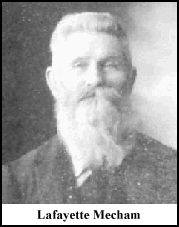
Though historians have been unable to verify Frank Mecham's claim that his father built the road in 1867, there is evidence that the road was in use at least by the latter part of 1868. In October of that year Lane began running an advertisement for the upper crossing ranch in which he claimed he had the best hay and barley on the river at what he had aptly renamed Pioneer Station.
The station was located, he said, along a "new road" on the west (some would call it south) side of the river. This second new road was a connection between Mecham's road and Lane's Crossing (Pioneer Station), which today is roughly the alignment of "D" Street, National Trails Highway and Turner Ranch Road.
SETTLEMENT BEGINS NEAR MECHAM'S ROAD
Sometime between 1868 and 1870, John Jacob Atkinson built a structure located where Mecham's road crossed the river approximately at what is now Sixth and "D" Streets. The structure definitely was there prior to September 26, 1870, because it appears in a legal description written by J. L. Mathews, who filed a claim on adjacent property on that date.
Also on September 26th, two other claims were filed northwest of Mathews’, one by A. F. (Frank) McKenney and the second by Jesse W. Taylor. The reason for this interest in land along Mecham’s road was that the stage line had begun using the new shorter route.
McKenney and Taylor formed a partnership and combined their property, located about one-quarter mile downstream from where today’s I-15 freeway crosses the river. The place occasionally was called McKenney and Taylor's Ranch, but the name McKenney's Station was the most popular and it was referred to as such in most of the records of the time, probably because McKenney was the partner who resided there.
In that same month of September, Joseph Brown, who went into partnership with his brother James, filed on 160 acres of land about two and one-half miles upstream of the new crossing. This was adjacent to the 480 acres a third brother, John Brown, Jr., had purchased the year before. These two properties included the land on which Spring Valley Lake is now situated, James and Joseph's encompassing the north portion of the lake, and John's the south.
The Brown family increased their holdings over the course of time to include property extending to the vicinity of the upper narrows on the north, and Bear Valley Road on the south. The spread was known as the Brown Ranch during the family’s ownership. It later became the Verde Ranch, and eventually, the Kemper Campbell Ranch, which today is a well-known landmark.
HUNTINGTON'S STATION
In December of 1872 McKenney and Taylor sold their ranch to J. C. Farley and William Aitken. The sale may have been prompted by the loss of McKenney’s son, who had died from typhoid the month prior to the transaction.
Just a few months later in August 1873, another death occurred at the station, that of co-owner J. C. Farley. Aitken subsequently gave up the station, and it passed into the hands of Heber Huntington, who made a major change in its operation. McKenney had provided fresh horses for the stages, blacksmithing services and meals, whereas Huntington established a trading post, supplying "provisions and ammunition," besides offering the previous services.

Huntington owned the station for several years before selling it to Frederick Audrey Bishop in May 1878. It was resold just two months later to Samuel Rogers, who operated it for the next six or seven years, although the area remained known as Huntington’s Station until the name was changed to Victor in 1885 when the railroad was completed.
Rogers relocated to a site nearer the upper narrows, and began a new station there. Its location, as well as that of other structures in the area of the future town of Victor, is shown in the sketch below, which was used in a lawsuit involving Rogers.
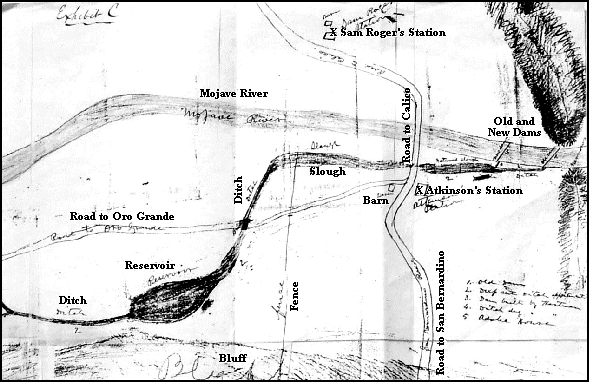
|
RIGHT PORTION OF THE SKETCH MAP FROM THE 1884 HARTMAN V ROGERS LAWSUIT. THE IDENTIFYING NAMES HAVE BEEN TYPED IN BECAUSE THE ORIGINAL SCRIPT IS HARD TO READ. THE ROAD HEADING NORTHERLY TO CALICO IS THE STODDARD WELLS ROUTE, WHICH CROSSED THE RIVER APPROXIMATELY AT TODAY'S INTERSECTION OF SIXTH AND D STREETS IN VICTORVILLE. REGRETTABLY THE SKETCH DOES NOT INCLUDE HUNTINGTON'S STATION. IT WAS NOT PART OF THE SUIT, BEING LOCATED ABOUT A MILE DOWNSTREAM OF ROGER'S STATION. REMNANTS OF THE DITCHES STILL EXIST, TRAVERSING WHAT WOULD LATER BECOME "OLD TOWN" AND CONTINUING ON DOWN PAST THE PRESENT-DAY CEMENT PLANT. OFF TO THE LEFT OF THE MAP, NOT SHOWN HERE, IS FARMLAND, SUCH AS CORN AND BARLEY FIELDS. |
LANE'S CROSSING BECOMES TURNER RANCH
Except for Lane’s advertisement for the Pioneer Station, the records are silent for the duration of Lane v Andrews regarding the ranch at the upper crossing. The next time the property is mentioned is in the newspapers in 1875, when two sons of San Bernardino hotelier John F. Miller appear on the Delinquent Tax List published in the February 5th San Bernardino Daily Argus.
Joshua Miller and his brother, John Norman Miller (who was incorrectly identified as John F. Miller, Jr., in the notice), were listed as owning quarter section claims of about 160 acres each, with John's parcel being a portion of the original Lane claim. Another portion of the claim was also held by members of the Miller family -- the section that had been disputed by Highmoor.
The property then passed from the Millers to Huldah Pearl and her husband, Alexander Hamilton Pearl, who was an old friend of Lane's from his Amador County days and had testified on his behalf in the pension matter. In 1883 the Pearls sold Lane's 160-acre parcel in Section 30, and another 80 acres in the southern part of Section 31, to Robert Turner for $2500.
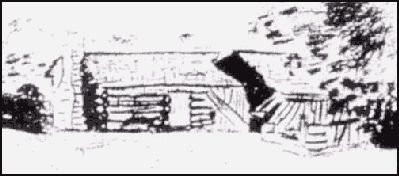
When Lane began at the crossing he had very modest means, but by the mid-1860s he had increased his holdings to the point where, although not well-to-do, he at least was no longer poor. By 1863 he owned a small amount of stock for breeding or to provide milk and meat for his guests. He had also taken up beekeeping.
Lane was in the forefront of the honeybee enterprise, since the business had only been introduced into San Bernardino County in 1860. The honey would have seemed quite a delicacy out on the desert, and especially would have been a treat for those dispirited by the terrible journey from Las Vegas to the Mojave River.
By 1865 he had a modest herd of a size that would permit him to sell stock, putting him on the road to being the rancher to which he aspired.

|
THIS MAP SURVEYED DURING THE 1870'S SHOWS THE ROAD ALONG THE MOJAVE RIVER (LEFT SIDE OF MAP) AND THE WAY STATIONS ON THE ROUTE: LANE'S CROSSING, POINT OF ROCKS, COTTONWOODS, GRAPEVINE, AND FISH PONDS. THE ROAD MECHAM CUT CAN BE SEEN RUNNING SOUTHWEST FROM FISH PONDS (TOP RIGHT OF MAP) TO ITS TERMINUS AT HUNTINGTON'S STATION (LITTLE MEADOWS). ALSO SHOWN IS THE ROAD CONNECTING MECHAM'S ROUTE TO LANE'S CROSSING (LATER PIONEER STATION). |
When Aaron moved, interest in events on the Mojave River moved downstream with him. The historic crossroad faded from the pages of the newspapers, and almost 20 years passed before the ranch again catered to travelers on the desert.
When Robert Turner bought the property in 1883 and established an inn, the old crossing came to life once again. Robert's wife, Susan, became renowned for her cooking, and the travelers on the old road began to make a point of stopping at Turner's Ranch.
This revival was brief, however, because when the railroad came to the area two years later, the center of activity switched to the train depot in the new town of Victor. The Turners moved their business enterprise to the town, and the upper crossing slipped back into a rural byway.

 PAGE
1|
2|
3|
4|
5|
6|
7|
8|
9|
10|
11|
12
PAGE
1|
2|
3|
4|
5|
6|
7|
8|
9|
10|
11|
12

